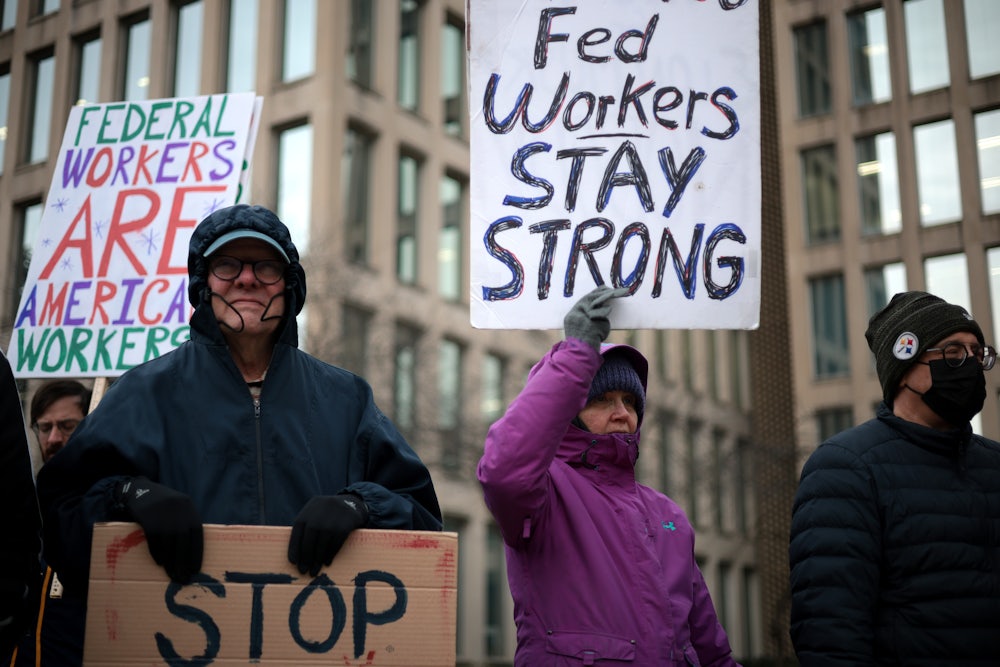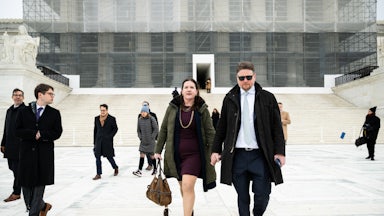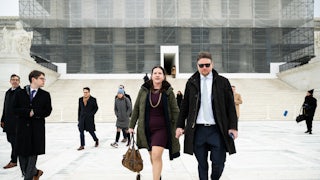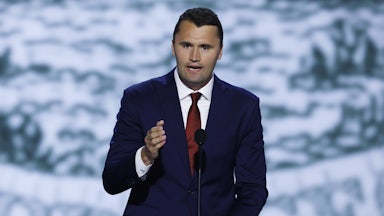It probably goes without saying, but the Trump administration’s blizzard of executive orders have been more numerous, far-reaching, and cataclysmic than liberals—and even conservatives—foresaw. Naturally, this has provoked instant pushback in courts, the op-ed pages, and press releases from elected officials. What was more predictable, however, is the target of the president’s counterstrikes: assaults on well-telegraphed targets such as birthright citizenship, migrants and asylum-seekers, and diversity, equity, and inclusion programs.
Less attention has been paid to spotlight—let alone quash—Trump’s gambit to exponentially magnify his power to weaponize the federal government to better advance his personal, partisan, illegal, or otherwise corrupt designs. The ne plus ultra of his dictator-on-Day-One executive orders empowered him with the ability to summarily fire, demote, transfer, harass, or otherwise abuse any career employee whose job he, or his political appointees, deems to be a “policy-influencing” position. This diktat would transform all career civil servants into actual or potential at-will employees, with no substantive or due process legal job security, just as if they were political appointees having never had any expectation of serving beyond that president’s term in office. Naturally, virtually all federal employees, regardless of their rank, of needs must “influence” policy; Article 2 of the Constitution defines their role, as members of the executive branch, as the execution of policies enacted by Congress.
At this juncture, the only hope to counter Trump’s subversive enterprise lies with the federal courts—ultimately, the Supreme Court. Congressional Republicans’ near-total capitulation has paved the way for normal political boundaries to be all but erased. Persuading and enabling federal judges—to say nothing of the Supreme Court’s justices—to block this administration’s yen to shred laws and the Constitution will be an imposing challenge. But not an insuperable one, if done the right way.
The “right way” means two things: First, one must craft legal arguments capable of peeling off at least two of the six Republican-appointed conservative justices, and that resonate widely enough to embolden the court to stand up to an administration openly proclaiming a “post-constitutional order,” flaunting its scorn for judges and justices whom Trump himself appointed, as “squishes,” and for the Federalist Society, which recommended their selection, as “not know[ing] what time it is.” Second, constitutional defenders must roll out—fast—and implement a bipartisan messaging strategy that will build media, political, and public support for those arguments. When the battle reaches the Supreme Court, the off-the-court environment must have already framed the issues along lines configured to win a majority there and defend that outcome in relevant opinion-shaping arenas.
At first blush, getting five Supreme Court votes may appear a prohibitively steep climb. This is because the statutory phrase on which the Trump team relies excludes from civil service protections any employee “whose position has been determined to be of confidential, policy-determining, policy-making, or policy advocating character and has been excepted from the competitive service by the President.” The executive order, and its architect, Office of Management and Budget Director Russell Vought, read that language to confer on the president unlimited discretion to define what constitutes “policy-determining, policy-making, or policy-advocating” character.
But on examination, Vought’s interpretation plainly fails, even—especially—with a court whose members all espouse fidelity to the text of statutes they are asked to apply, for two reasons: First, Vought mischaracterizes the statutory language on which he relies. Contrary to the executive order, the statutory terms “policy-determining, policy-making, policy-advocating” are not equivalent to “policy-influencing.” As noted above, all or virtually all federal employee positions can be characterized as policy-influencing. But only a thin layer at the top—most of them political appointees, not career officials—determine, make, or advocate policy; the rest provide information, perform research, apply and carry out their superiors’ decisions and directions.
Indeed, an Office of Personnel Management regulation still in effect as of January 30 expressly provides that “Confidential, policy-determining, policy-making, or policy-advocating means of a character exclusively associated with a noncareer political appointment.” (Trump’s lawyers had evidently not proposed to repeal this regulation, presumably to avoid the stringent procedures required by the Administrative Procedure Act.)
Moreover, apart from leaving this conflicting regulation in place and misreading the very statutory words on which he and his team base their case, Supreme Court precedent and common sense mandate that proper statutory interpretation can never thus pluck out of context words or phrases and view them in isolation. The relevant context means the statute as a whole, its language, legislative, implementation, and judicial history, and its purposes, especially as those purposes are specified in the statute itself.
In this case, the relevant statutory context comprises the text and history of the civil service laws, as codified in former President Jimmy Carter’s Civil Service Reform Act of 1978, which built on the 1883 Pendleton Civil Service Reform Act. Those landmark enactments created and strengthened the modern merit-based civil service system, to replace the notoriously corrupt “spoils system” that marred the first century of the American republic. That prism exposes Vought’s argument as a contorted misread, to dismember the elaborate legal edifice in which the phrase is embedded.
Rebuffing Trump’s attempted coup is not as implausible as the existing 6–3 Republican-appointed majority may suggest. “Significantly,” as law professors William Eskridge, Brian Slocum, and Kevin Tobia tallied in September 2023:
[Liberal justices] Sotomayor, Kagan, and Breyer or Jackson were all in the majority for thirteen of nineteen cases [in which the six conservatives split since Justice Gorsuch joined the Court in April 2017], Roberts and Kavanaugh were in the majority for fifteen cases and Barrett for eleven of the fifteen cases for which she sat. But Thomas, Alito, and Gorsuch were in the majority for only seven cases apiece. Interestingly, Roberts and Kavanaugh voted more often in these cases with Sotomayor and Kagan than with Thomas and Gorsuch.
The records of the Trump-appointed justices, in their opinions, comments in oral arguments, and off-court writings and statements, suggests that two or more of them, plus the three liberal justices, could come together to overturn the Trump-Vought executive order.
Key to attaining that result is a 2015 decision, King v. Burwell, which rejected an analogous, acontextual, isolated-phrase-based attempt to undermine the Affordable Care Act. Had ACA opponents prevailed, the result would have rendered unworkable the entire section of the law providing subsidized insurance to lower- and middle-income subscribers—who numbered 24 million in 2024. Chief Justice John Roberts’s decision blocking that perverse result is a powerful precedent for quashing an executive order that would even more completely vaporize the long-established statutory framework undergirding a merit-based federal workforce.
In King, Roberts elaborated a blueprint for exegeses of complex landmark statutes. We “must,” he instructed, follow “the fundamental canon ... that the words of a statute must be read in their context and with a view to their place in the overall statutory scheme.”
“Here,” he reasoned, ACA opponents’ “interpretation would destabilize the individual insurance market … and likely create the very [chaos] that Congress designed the Act to avoid.… We cannot interpret federal statutes to negate their own stated purposes. It is implausible that Congress meant the Act to operate in this manner.” (Emphasis added.)
Pointedly, Roberts concluded with a mandate to follow Congress’s real-world operational design: “A fair reading of legislation demands a fair understanding of the legislative plan. (Emphasis added.) Congress passed the Affordable Care Act to improve health insurance markets, not to destroy them.”
Without doubt, Roberts’s detailed catechism was no off-the-cuff one-shot. Moreover, the King precedent would, if applied conscientiously, compel rejection of the Trump-Vought attempt to “undo” Congress’s “plan” for a merit-based civil service system, by arrogating to the president open-ended authority to unilaterally convert any federal employee into an at-will officeholder.
In his March 2, 1978, message transmitting the proposed Civil Service Reform Act, or CSRA, to Congress, Carter described its “objectives” as, first “to strengthen the protection of legitimate employee rights,” and second, “to provide incentives and opportunities for managers to improve the efficiency of the Federal Government.”
To attain the second, efficiency-enhancing objective, the act’s principal innovation was the establishment of a “Senior Executive Service,” or SES, to be populated by both political appointees and senior career appointees. But the CSRA did NOT make SES positions at-will, as does the executive order for any position the president designates. On the contrary, the act detailed substantive standards for determining and disciplining SES members for inadequate performance; adverse actions for inadequate performance can include removal from the SES—but NOT from federal employment altogether. Stricter criteria and procedural safeguards (and penalties, including termination of federal employment) are prescribed for “misconduct.” In all cases, SES procedures include “advance notice [of any proposed disciplinary action], reasonable time to reply, representation, and a written decision by the agency.” All these protections are still codified on the books.
Were the executive order’s regime authorized by the CSRA, there would have been no need to carve out an SES to give the president and political appointees increased management flexibility, and carefully delineate criteria and procedures governing SES officials’ performance, evaluation, and discipline.
To circumvent these decades-old foundational safeguards, Vought and his team hang their hat on a change made by a 1990 amendment to the civil service laws codified in 1978. That amendment rephrased provisions governing administrative “exceptions” to placing positions in the “competitive service”—hence, removing such positions from otherwise applicable employee protections. But this 1990 amendment was written to expand federal employees’ protections, not constrict, let alone eliminate them. Indeed, the purpose of the 1990 amendment, stated in the opening sentence of the House Committee Report accompanying it to the House floor, “is to extend to certain employees in the excepted service the same administrative notice and appeal procedures currently provided employees in the competitive service.” Further, as the Committee Report stressed:
The fact that an employee is not in the competitive service does not mean that the employee can be hired or fired at whim.… Nor can employees in excepted service positions be fired without notice.
In keeping with the express rights-protective purpose of the amendment on which the executive order relies, Vought’s ploy plainly flunks the strictures for contextual interpretation laid down in King v Burwell.
The executive order’s bid to bypass the King precedent rests on a hope that changes in the court’s membership will jettison Roberts’s commitment to commonsense contextual interpretation. Since 2015, when King was decided, two members of Roberts’s 6–3 majority have left the court—liberal Justice Ruth Bader Ginsburg and maverick-conservative Justice Anthony Kennedy. Assuming that Roberts will stand by his own precedent, he will need at least one other conservative to make a majority, joining himself and the three liberal justices (Sonia Sotomayor, Elena Kagan, and Ketanji Brown Jackson). There is good reason to expect that, properly framed and publicly supported, a challenge can gain votes from at least one and quite possibly more of this more right-tilted court.
The most likely candidate to join Roberts and the liberal justices is Justice Brett Kavanaugh. On the high court, on his prior perch, the D.C. Circuit Appellate Court, and in extrajudicial writings, Kavanaugh has shown an affinity for interpreting major statutes holistically, in sync with Roberts’s King v. Burwell operational focus, their purposes, and their implementation history.
Most recently, in a dissent joined by Roberts, Sotomayor, and Kagan, Kavanaugh attacked a five-justice majority’s rejection of a bankruptcy district court’s resolution of the Purdue Pharma–Sackler family OxyContin catastrophe settlement. Kavanaugh led off his argument writing that the district judge’s “plan was a shining example of the bankruptcy system at work.… But the Court now throws out the plan—and [practices] which have long been a critical tool for bankruptcy courts to manage mass-tort bankruptcies like this one. The Court’s decision finds no mooring in the Bankruptcy Code.” (Emphasis added.)
The Purdue Pharma bipartisan majority included Justice Jackson (who presumably agreed that remanding the case could force the Sacklers to acquiesce in a better deal for their OxyContin victims—as may have transpired last month). In a challenge to the Trump-Vought executive order, Jackson would surely form a fifth vote to reject any such order.
In 2023, Kavanaugh wrote a lengthy opinion joined by the three liberal justices (Sotomayor, Kagan, and Jackson), concurring in a unanimous judgment that the Environmental Protection Agency exceeded its Clean Water Act authority when it barred a landowner from building on dry land standing between two sites covered by the CWA—a navigable waterway and a wetland. But Kavanaugh and the three liberals disputed the majority’s reversal of a “longstanding and consistent agency interpretation” of the act embraced by “eight administrations since 1977.” Kavanaugh added that the court’s rejection of long-standing agency practice would have substantial real-world consequences inimical to the manifest purpose of the act: “By narrowing the Act’s coverage … the Court’s new test will [have] significant repercussions for water quality and flood control throughout the United States.”
In addition to Kavanaugh, Justice Amy Coney Barrett seems likely to be skeptical of the Trump-Vought emasculation of the merit-based civil service statutory framework, if opponents frame their attacks as based on “commonsense,” long-standing agency and judicial practice, and contextual interpretation confirming close reading of the particular statutory phrase at issue. Barrett’s increasingly outspoken willingness to break with her conservative colleagues has been widely noted; during the 2023–24 term, Barrett voted “for the liberal outcome on 48% of divided cases with an ideological bent, the highest percentage among the Republican appointees.” At the end of that term, Barrett authored, on behalf of herself and the three liberal justices, a blistering, extensively documented dissent to a 5–4 majority’s grant of a preliminary injunction against a “major” EPA rule, on the basis of a “barely briefed … undeveloped theory [that] leaves large swaths of upwind States free to keep contributing significantly to their downwind neighbors’ ozone problems for the next several years.”
Even Justice Neil Gorsuch, frequently considered one of the court’s furthest-right members, would seem potentially susceptible to textualist arguments that highlight the ahistorical distortion of the text on which Vought and his team rely. That approach produced Gorsuch’s blockbuster 2021 decision that anti-LGBTQ practices violate the ban in Title VII of the 1964 Civil Rights Act on workplace “discrimination because of sex.”
To put it another way, Trump and his team have every reason to recognize Justices Kavanaugh, Barrett, and even Gorsuch as Trump appointees but not necessarily “Trump justices.” On the contrary, they and the court they control could well constitute a uniquely critical threat to their agenda of consolidating all federal power in the president’s hands. Already, the first federal branch, Congress, has acquiesced in its own marginalization. The justices need to grasp that Trump’s “career/policy” executive order, along with other unlawful actions, targets the court itself, aiming to marginalize the third branch’s independent constitutional role. If there is no law that the president feels bound to respect, that Congress will defend, or that citizens can rely on, then there is no role for federal judges other than as bystanders or rubber stamps.
In order to avoid that fate, the court cannot embrace the normal routine of deferring a decision to strike down the administration’s law-breaking until after cases have wound their way up the multiyear ladder from trial to appeals to the high court. In the meantime, of course, Trump and his agency heads will gleefully terminate, or in Vought’s words, “traumatize” into resigning, tens or perhaps hundreds of thousands of worthy career officials.
This exigent need for fast disposition is recognized by the sole court challenge to this executive order that, to my knowledge, has yet been filed, by the National Treasury Employees Union, or NTEU. Noting that the executive order “explicitly states that OPM regulations in conflict with the order ‘shall be held inoperative and without effect,’” the NTEU complaint seeks a declaration that the executive order is unlawful, and an injunction barring Trump or his appointees from “implementing or enforcing” the order. The court’s own independence as the constitutionally designated head of a coequal branch of government requires just such an immediate interment of the administration’s bid to marginalize its authority to “determine what the law is,” as Chief Justice John Marshall ruled magisterially in 1803.
For their part, liberal leaders need to break free from their subject-matter silos and recognize the priority stake they and their constituencies have in securing that outcome in this case. Russell Vought has said, with disarming candor, that his strategic lodestar is that “personnel is policy.” On that point, Trump’s COO is 100 percent correct: Nowhere can liberal policies be expected to live to fight another day if the personnel executing those policies are replaced, down as well as up the line, by hacks dedicated to dismantling them. Liberal lawyers, activists, advocates, and politicians must mobilize their constituents and allies and assemble broad coalitions—including independents and rule-of-law conservatives—to detail the devastating impacts the Trump-Vought assault portends. To that end, they must deploy message points calculated both to galvanize popular support and to appeal to the justices whose votes are needed and within reach: namely, the Trump appointees whom he and his allies disdain as independent potential threats, not grateful vassals.










